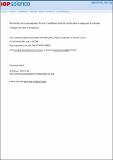Pan-Arctic land–atmospheric fluxes of methane and carbon dioxide in response to climate change over the 21st century
Author(s)
Zhu, Xudong; Zhuang, Qianlai; Gao, Xiang; Sokolov, Andrei P.; Schlosser, Adam
DownloadXudong-2013-Pan-arctic Land-atmo.pdf (2.991Mb)
PUBLISHER_CC
Publisher with Creative Commons License
Creative Commons Attribution
Terms of use
Metadata
Show full item recordAbstract
Future changes of pan-Arctic land–atmospheric methane (CH[subscript 4]) and carbon dioxide (CO[subscript 2]) depend on how terrestrial ecosystems respond to warming climate. Here, we used a coupled hydrology–biogeochemistry model to make our estimates of these carbon exchanges with two contrasting climate change scenarios (no-policy versus policy) over the 21st century, by considering (1) a detailed water table dynamics and (2) a permafrost-thawing effect. Our simulations indicate that, under present climate conditions, pan-Arctic terrestrial ecosystems act as a net greenhouse gas (GHG) sink of −0.2 Pg CO[subscript 2]-eq. yr[superscript −1], as a result of a CH[subscript 4] source (53 Tg CH4 yr[superscript −1]) and a CO[subscript 2] sink (−0.4 Pg C yr[superscript −1]). In response to warming climate, both CH[subscript 4] emissions and CO[subscript 2] uptakes are projected to increase over the century, but the increasing rates largely depend on the climate change scenario. Under the non-policy scenario, the CH[subscript 4] source and CO[subscript 2] sink are projected to increase by 60% and 75% by 2100, respectively, while the GHG sink does not show a significant trend. Thawing permafrost has a small effect on GHG sink under the policy scenario; however, under the no-policy scenario, about two thirds of the accumulated GHG sink over the 21st century has been offset by the carbon losses as CH[subscript 4] and CO[subscript 2] from thawing permafrost. Over the century, nearly all CO[subscript 2]-induced GHG sink through photosynthesis has been undone by CH[subscript 4]-induced GHG source. This study indicates that increasing active layer depth significantly affects soil carbon decomposition in response to future climate change. The methane emissions considering more detailed water table dynamics continuously play an important role in affecting regional radiative forcing in the pan-Arctic.
Date issued
2013-10Department
Massachusetts Institute of Technology. Center for Global Change Science; Massachusetts Institute of Technology. Joint Program on the Science & Policy of Global ChangeJournal
Environmental Research Letters
Publisher
IOP Publishing
Citation
Zhu, Xudong, Qianlai Zhuang, Xiang Gao, Andrei Sokolov, and C Adam Schlosser. “Pan-Arctic land–atmospheric fluxes of methane and carbon dioxide in response to climate change over the 21st century.” Environmental Research Letters 8, no. 4 (December 1, 2013): 045003.
Version: Final published version
ISSN
1748-9326